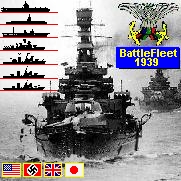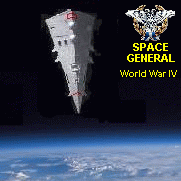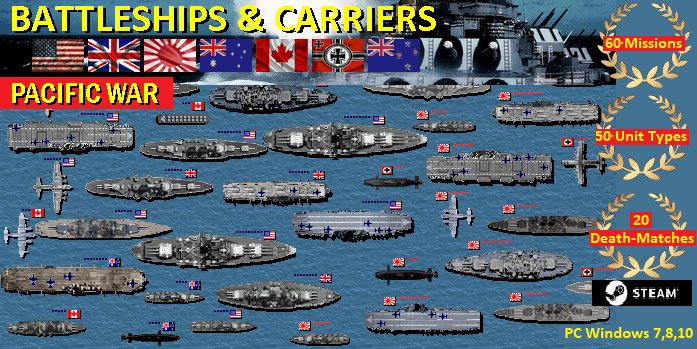USS Ronald
Reagan
USS Abraham
Lincoln Aircraft Carrier
USS
Enterprise Aircraft Carrier
Naval Navy
Tactics ASW AAW
5th US
Fleet
US 6th
Fleet
US 7th
Fleet
USS Ranger
Aircraft Carrier
USS
Forrestal
USN
Cruisers
USN
Destroyers
US Navy
Amphibious
Assault Ships - LHA/LHD/LHA(R)
SSN Attack
Sumbarines 1
USN
Frigates
USN Patrol
Ships
Submarine
www.battle-fleet.com
Battleship Game - WW2 Naval Strategy: the best
choice among aircraft carrier games
and submarine games.
Missions and Scenarios:
Pearl Harbor Game
Atlantic Game 1943
Sink Cruisers Game
Midway Game
Iwo Jima Game
US Marines Game
Luftwaffe Game Pacific
Torpedo Game Boats
Bismarck Game Pacific
Destroy RAF Game
Okinawa
Us Navy Submarine Game
Fleet Submarines Game
Kamikaze Game
U Boat Game
Singapore Game
Swordfish Hunt
Patrol Boats
Air Supremacy
Alert
Battleships Game
Java
Defense
Fleet Cruisers Game
Atlantic Island
Coral Sea Game
Iron Sea
Mykonos
Imperial Ocean
Long Convoy
Skagerrak
Target Los Angeles
West Pacific Game
Pacific War Game
Leyte Transport
Emperor Hirohito
Normandy Game
South Pacific Game
Destroy USAF Game
Submarine Games
US Navy Game
Free Hunt Doenitz Game
Free Hunt Spruance Game
Free Hunt Halsey Game
Imperial Navy I
Royal Navy Game
Free Hunt Pearl Harbor Games
Midway II
Kriegsmarine I
Brisbane Convoy
Clear West Coast
Fall Of Australia
Battle For Leyte
Conquer Of Japan
HMAS Perth
Road To Okinawa
Orange Ports
Emperor Defense
Prince Of Wales
San Bernardino
Pacific Race
Heavy Duty
Tokio Express
Operation Sidney
Bomber Operation
Conquer Of Italy
Heavy Cruiser Game
Frigate Hunt
Santa Cruz
Lamansh Game
Azores Transport
Norway Convoy
Invasion
Grossadmiral
Norway Ports
Drang Nach Ost
Convoy Pk30
Ciano Defense
Sir John Tovey
Free Hunt Andrews
Germans On Pacific
Silent Hunt
Antigua
Return To Midway
Kriegsmarine Game II
Royal Air Force Game
F. Hunt Lancaster
Jamamoto Game
Free Hunt USN
Free Hunt Japan
Free Hunt RAAF
Free Hunt U Boat Game
Free Hunt Aircraft Carriers Game
Free Hunt Hawaii
Free Hunt Yamato Game
Free Hunt Iwo Jima Game
Free Hunt Pacific Game
Free Hunt Torpedos
Free Hunt Convoy
Free Hunt Germany
Free Hunt Germany II
Free Hunt Italy
Free Hunt Malaya
Free Hunt Subs Game
Free Hunt B-29 Game
Free Hunt USN 1944
Devil Island
Dragoon Carriers Game
|
|
Supercarrier
 |
Supercarrier
Aircraft Carrier |
A supercarrier is a word
sometimes used to describe a form of aircraft carrier,
with no official meaning. It is generally considered to
be 75,000 tons or greater in displacement — most
countries operate carriers with a displacement of less
than 40,000 tons (such as Charles de Gaulle), and more
often closer to 15,000 (such as HMS Illustrious.)
The 81,000 ton USS Forrestal was the first operational
supercarrier, though United States would have been in
service earlier, had it been completed; its cancellation
triggered the "Revolt of the Admirals." United
States would have had a nuclear strategic bombing role,
rather than the multipurpose role that all subsequent
supercarriers have had, carrying tactical aircraft only
for defense. The 72,000 ton armored Japanese carrier
Shinano of the World War II era was almost heavy enough
to be considered a supercarrier, but lacked several
defining features, such as catapults, arrestor cables,
and angled flight decks, and also did not possess the
sheer size of modern supercarriers. Because of the angled
deck and large deck area, supercarriers can have a far
larger island than conventional carriers, greatly
improving both their aviation capabilities and their
capability as flagships.
The U.S. Navy is currently
the only major sea power, and all completed supercarriers
are American, of which the 100,000 ton Nimitz class is
the most prolific. However the governments of the United
Kingdom and France have both approved plans to build
several new large carriers for their navies. The Thales
Group has been commissioned to build both country's
ships, which will be 50-60,000 tons, still significantly
smaller than the American Nimitz class, but large enough
to be considered supercarriers. They are scheduled to
become operational between 2012 and 2015. For more
information, see Royal Navy CVF programme and Future
French aircraft carriers. Adionionally, in the 1980s the
Soviet Union began construction of Ulyanovsk, an 85,000
ton nuclear carrier comparable in size to earlier
American supercarriers. Ulyanovsk was 40% complete when
cancelled (along with a follow-on vessel) due to lack of
funding after the end of the Cold War in 1991.
Supercarrier - Aircraft Carrier classes
United States (USA,
1950s) - Single-unit laid down, cancelled along with four
others
Forrestal class (USA, 1955) - Four unit class, all
decommissioned
Kitty Hawk class (USA, 1961) - Three unit class, two
decommissioned, one active
Enterprise (USA, 1961) - Single-unit class, still active
John F. Kennedy (USA, 1968) - Single-unit class, a
modified Kitty Hawk design, still active
Nimitz class (USA, 1975) - Final unit (of ten) scheduled
for completion in 2009, all units still active
Ulyanovsk (USSR, 1990s) - Two units cancelled after
partial completion
CVN-21 (USA, 2013) - Two units pending
| CIA / KGB intelligence game. Run your own operation game.
Travel around the world and set up espionage
game, trade with state secrets, weapon systems,
spy codes, WMD, hire secretaries, agents, lawyers
and soldiers, establish secret agent stations,
cells and bases and search for criminals and
politicians. Involve in agent game. Game contains
more than 40 missions including Nuclear Game,
Cold War Game, Secret Agent, CIA Games, USAF,
Prime Minister, RAF, Bin Laden, Sadam, KGB,
Operations Iran… |
|
Nimitz-class
supercarriers are a class of ten nuclear-powered aircraft
carriers in service with the United States Navy. With an
overall length of 1,092 ft (333 m) and full-load
displacements of over 100,000 long tons, they are the
largest capital ships in the world. Instead of the gas
turbines or diesel-electric systems used for propulsion
on many modern warships, the carriers use two A4W
pressurized water reactors which drive four propeller
shafts and can produce a maximum speed of over 30 knots
(56 km/h) and maximum power of around 260,000 shp (190
MW). As a result of the use of nuclear power, the ships
are capable of operating for over 20 years without
refueling and are predicted to have a service life of
over 50 years. They are categorized as nuclear-powered
aircraft carriers and are numbered with consecutive hull
numbers between CVN-68 and CVN-77.
All ten supercarriers were constructed by Newport News
Shipbuilding Company in Virginia. USS Nimitz, the lead
ship of the class, was commissioned on 3 May 1975 and USS
George H. W. Bush, the tenth and last of the class, was
commissioned on 10 January 2009. Since the 1970s,
Nimitz-class carriers have participated in many conflicts
and operations across the world, including Operation
Eagle Claw in Iran, the Gulf War, and more recently in
Iraq and Afghanistan.
The angled flight decks of the carriers use a CATOBAR
arrangement to operate aircraft, with steam catapults and
arrestor wires for launch and recovery. As well as
speeding up flight deck operations, this allows for a
much wider variety of aircraft than with the STOVL
arrangement used on smaller carriers. An embarked carrier
air wing consisting of up to around 90 aircraft is
normally deployed on board. The air wings' strike
fighters are primarily F/A-18E/F Super Hornets and
F/A-18C Hornets, after the retirement of the F-14 Tomcat.
In addition to their aircraft, the vessels carry
short-range defensive weaponry for anti-aircraft warfare
and missile defense.
The Nimitz-class aircraft supercarriers were ordered to
supplement the aircraft carriers of the Kitty Hawk class
and Enterprise class, maintaining the strength and
capability of the US Navy after the older carriers were
decommissioned. The ships were designed to be
improvements on previous US aircraft carriers, in
particular the Enterprise and Forrestal-class
supercarriers, by using a more modern design, although
the arrangement of the ships, in particular that of their
flight decks, is relatively similar to that of the Kitty
Hawk class. Among other design improvements, the two
reactors on Nimitz class carriers take up less space than
those on Enterprise, which uses eight, meaning there is
more interior space. This, along with a more generally
improved design, means that Nimitz-class carriers can
carry 90 percent more aviation fuel and 50 percent more
ordnance when compared to the Forrestal class. The US
Navy has also stated that the carriers could withstand
three times the damage sustained by the Essex class
inflicted by Japanese air attacks during World War 2. The
hangars on the ships are divided into three fire bays by
thick steel doors that are designed to restrict the
spread of fire. This addition has been present on US
aircraft carriers since World War 2, after the fires
caused by Kamikaze attacks.
The first ships were designed around the time of the
Vietnam War, and certain aspects of the design were
influenced by operations there. To a certain extent, the
carrier operations in Vietnam demonstrated the need for
increased capabilities of aircraft carriers, over their
survivability, as they were used to send sorties into the
war, and were therefore less subject to attack. As a
result of this experience, Nimitz carriers were designed
with larger stores of aviation fuel and larger magazines
in relation to previous carriers, although this was
partly as a result of increased space available due to
the arrangement of the ships' propulsion systems.
A major purpose of the ships was initially to support the
US military during the Cold War, and they were designed
with capabilities for that role, including using nuclear
power instead of oil, for greater endurance when deployed
in blue water, and the ability to make adjustments to the
carriers' weapons systems on the basis of new
intelligence and technological developments. They were
initially categorized only as attack carriers, but ships
have been constructed with anti-submarine capabilities
since USS Carl Vinson. As a result, the ships and their
aircraft are now able to participate in a wide range of
operations, which can include sea and air blockades, mine
laying, and missile strikes on land, air and sea. The
total cost of construction for each ship was around $4.5
billion.
In addition to the aircraft carried onboard, the ships
carry defensive equipment for direct use against missiles
and hostile aircraft. These consist of either three or
four NATO RIM-7 Sea Sparrow missile launchers, designed
for defense against aircraft and anti-ship missiles as
well as either three or four 20 mm Phalanx CIWS missile
defense cannons. USS Ronald Reagan has none of these,
having been built with the RIM-116 Rolling Airframe
Missile system, two of which have also been installed on
USS Nimitz and USS George Washington. These will be
installed on the other ships as they return for Refueling
Complex Overhaul (RCOH).[3][18] Since USS Theodore
Roosevelt, the carriers have been constructed with 2.5 in
(64 mm) Kevlar armor over vital spaces, and earlier ships
have been retrofitted with it: Nimitz in 1983–1984,
Eisenhower from 1985–1987 and Vinson in 1989.
The other countermeasures the ships use are four Sippican
SRBOC (super rapid bloom off-board chaff) six-barrel MK36
decoy launchers, which deploy infrared flares and chaff
to disrupt the sensors of incoming missiles; an SSTDS
torpedo defense system, and an AN/SLQ-25 Nixie torpedo
countermeasures system. The carriers also use Raytheon
AN/SLQ-32(V) electronic warfare systems to detect and
disrupt hostile radar signals in addition to the
electronic warfare capabilities of some of the aircraft
onboard.
The presence of nuclear weapons on board U.S. aircraft
supercarriers since the end of the Cold War has neither
been confirmed nor denied by the U.S. government. As a
result of this, as well as concerns over the safety of
nuclear power, the presence of a U.S. aircraft carrier in
a foreign port has occasionally provoked protest from
local people, for example when USS Nimitz docked in
Chennai, India, in 2007. At that time, the Strike Group
commander Rear Admiral John Terence Blake stated that:
"The US policy is that we do not routinely deploy
nuclear weapons on board Nimitz." Concern was also
voiced after the arrival and docking of the USS George
Washington in Yokosuka, Japan on 10 March 2011 following
the 2011 Tohoku earthquake and tsunami disaster. Hundreds
of protesters were present to make their voices heard
concerning the safety of the nuclear reactor on board the
warship providing aid.[citation needed]
Text is available under the terms of the GNU Free
Documentation License
|
Aircraft Carrier Game Class
overview:
USS Dwight D. Eisenhower Aircraft Carrier
USS Carl Vinson Aircraft Carrier
USS Theodore Roosevelt Aircraft Carrier
USS Abraham Lincoln Aircraft Carrier
USS George Washington Aircraft Carrier
USS John C. Stennis Aircraft Carrier
USS Harry S. Truman Aircraft Carrier
USS Ronald Reagan Aircraft Carrier
USS George H. W. Bush Aircraft Carrier
USS Ronald Reagan belongs
to the Nimitz-class supercarriers, a line of
nuclear-powered aircraft carriers in service with the
United States Navy, are the largest capital ships in the
world, and are considered to be a hallmark in the
superpower status of the United States of America. These
aircraft carriers are numbered with consecutive hull
numbers starting with the CVN-68. The letters CVN denote
the type of ship: "CV" is the hull
classification symbol for aircraft carriers, and
"N" indicates nuclear-powered propulsion. The
number after the CVN means that this is the 68th
"CV", or large aircraft carrier.
Nimitz (CVN-68), the lead ship of the class, was
commissioned on September 18, 1976. George H. W. Bush
(CVN-77), the tenth and last of the class, was built by
the Newport News Shipbuilding Company, and she entered
naval service on January 10, 2009. The USS George H.W.
Bush will be the first transition ship to the new Gerald
R. Ford-class, the first ship of which began construction
in 2007 and will incorporate new technologies including a
new multi-function radar system, volume search radars, an
open architecture information network, and a
significantly reduced crew requirement. To lower costs,
some new technologies were also incorporated into the
Ronald Reagan, the previous carrier to the George H.W.
Bush, though not nearly as many as will be involved with
George H.W. Bush.
| |
 |
 |
| Turn-based WW2
naval game, extension to the classic
Submarine game (Battleship game) where
ships/planes/subs can move. Contains plenty of
game missions, game campaigns and 40 ship,
submarine, airplane ana port artillery types,
with combat maps up to 96X96 large. |
| |
| |
|
Fashion Tycoon is
a business fashion management game.
You'll build your multinational fashion company,
destroy competition, hire employees, fashion
models and businessman, establish company
objects, run fashion shows and brand campaigns.
There is a more than 30 missions with different
game objectives. You can hire more than 100
fashion models, directors, brand experts,
celebrities. |
| |
 |
 |
Turn-based space
strategy game represents World War 4
conflict on tactical level.
The user-friendly game engine allows more than 60
unit types, including planet battleships, galaxy
cruisers, death-stars, stealth units, star
destroyers, air-space interceptors, explorers,
planet artillery and radars. |
| |
| |
 |
| Tycoon Strategy
Game - build your own world business empire as an
arms dealer tycoon. Travel around the world,
trade with more than 400 weapon systems, hire
secretaries, bodyguards, lawyers, fighters and
tanks, establish companies and search for
criminals and hostages. |
| |
Because of construction differences between the first
three ships (USS Nimitz, Dwight D. Eisenhower, and Carl
Vinson) and the latter seven (from Theodore Roosevelt
on), the latter ships are sometimes and erroneously
called Theodore Roosevelt-class aircraft carriers, though
the U.S. Navy considers them to all be in one class.[1]
As the older aircraft carriers come in for their
Refueling and Complex Overhaul, they are upgraded to the
standards of the latest ships.[2]
By tonnage, the Nimitz-class warships are the largest
aircraft carriers built so far, holding the world record
for displacement of any naval war vessel. After the
George H.W. Bush, was completed, the ten ships of this
class will total just under a million tons in combined
displacement. Although the Nimitz-class ships are the
heaviest ships in the US Navy fleet they are not the
longest ships in the fleet, with that distinction
belonging to the aircraft carrier Enterprise.
The USS Nimitz was the first warship of this class to
undergo her initial refueling during a 33-month RCOH at
the Newport News Shipbuilding Company in Newport News,
Virginia, in 1998. The Dwight D. Eisenhower was next,
completing its RCOH in 2005. The Carl Vinson began its
RCOH in late 2005. The USS Abraham Lincoln entered the
large drydock at Puget Sound Naval Shipyard on September
8, 2006, but she left ahead of schedule on December 18.
The Kitty Hawk-class super aircraft carriers of the
United States Navy were an incremental improvement on the
Forrestal-class vessels. Four were built, all in the
1960s,
Kitty Hawk Aircraft Carrier(CV-63) (1961–2009),
Constellation Aircraft Carrier (CV-64) (1961–2003),
America Aircraft Carrier (CV-66) (1965–1996)
John F. Kennedy Aircraft Carrier (CV-67)
(1967–2007).
All are now decommissionned.
The biggest differences from the Forrestals are greater
length, and a different placement of elevators; two are
forward of the island, one is aft of the island and
another on the portside stern. The movement of the #4
elevator from the forward to the after end of the angle
made it useful for aircraft movement, since the
forward-end elevator was useless as it was in both the
landing path and in the launch path of the #3 and #4
catapults.
Three different shipyards were used to construct the
ships. Kitty Hawk was built at New York Shipbuilding
Corporation, Constellation at New York Naval Shipyard,
America and John F. Kennedy at Newport News Shipbuilding.
John F. Kennedy is similar to the earlier units in
flightdeck arrangement and propulsion, but has enough
differences that she is often placed in her own class.
Propulsion consisted of four Westinghouse geared
turbines, 280,000 shp, four shafts with eight 1,200 psi
Foster Wheeler boilers.
|
